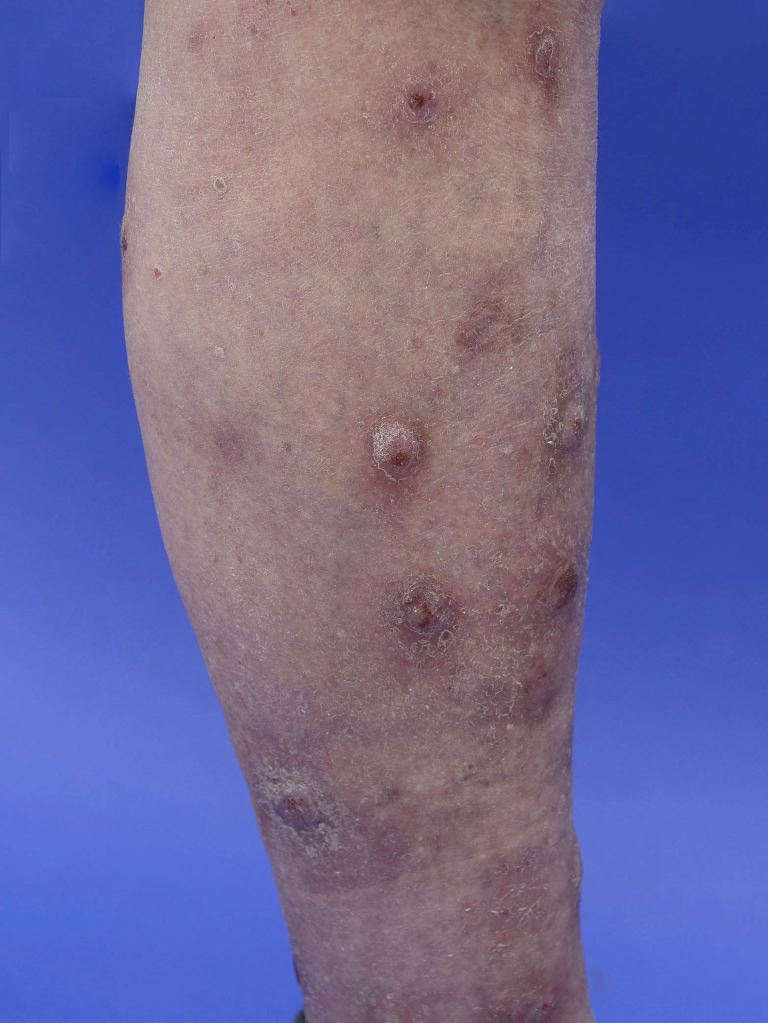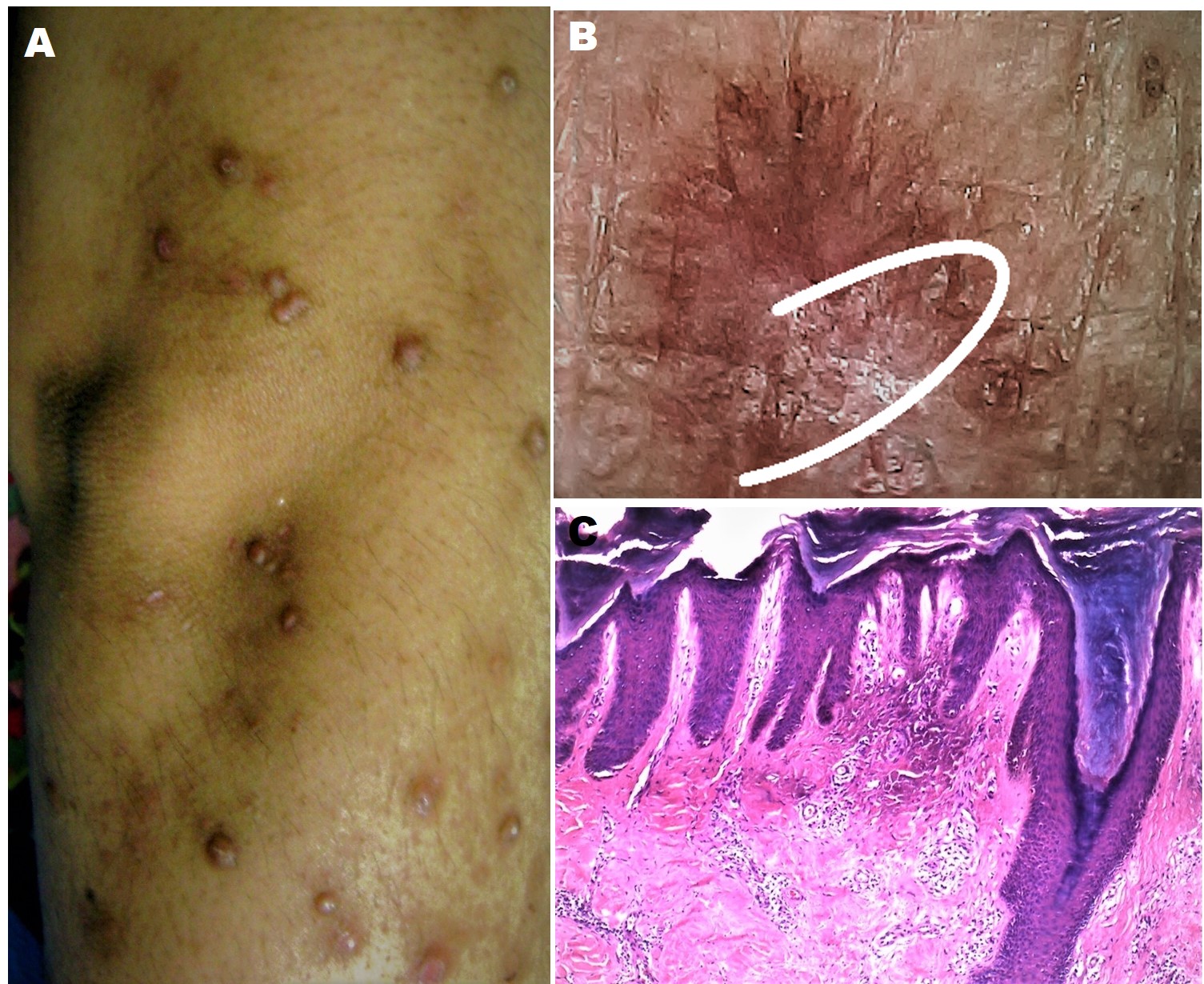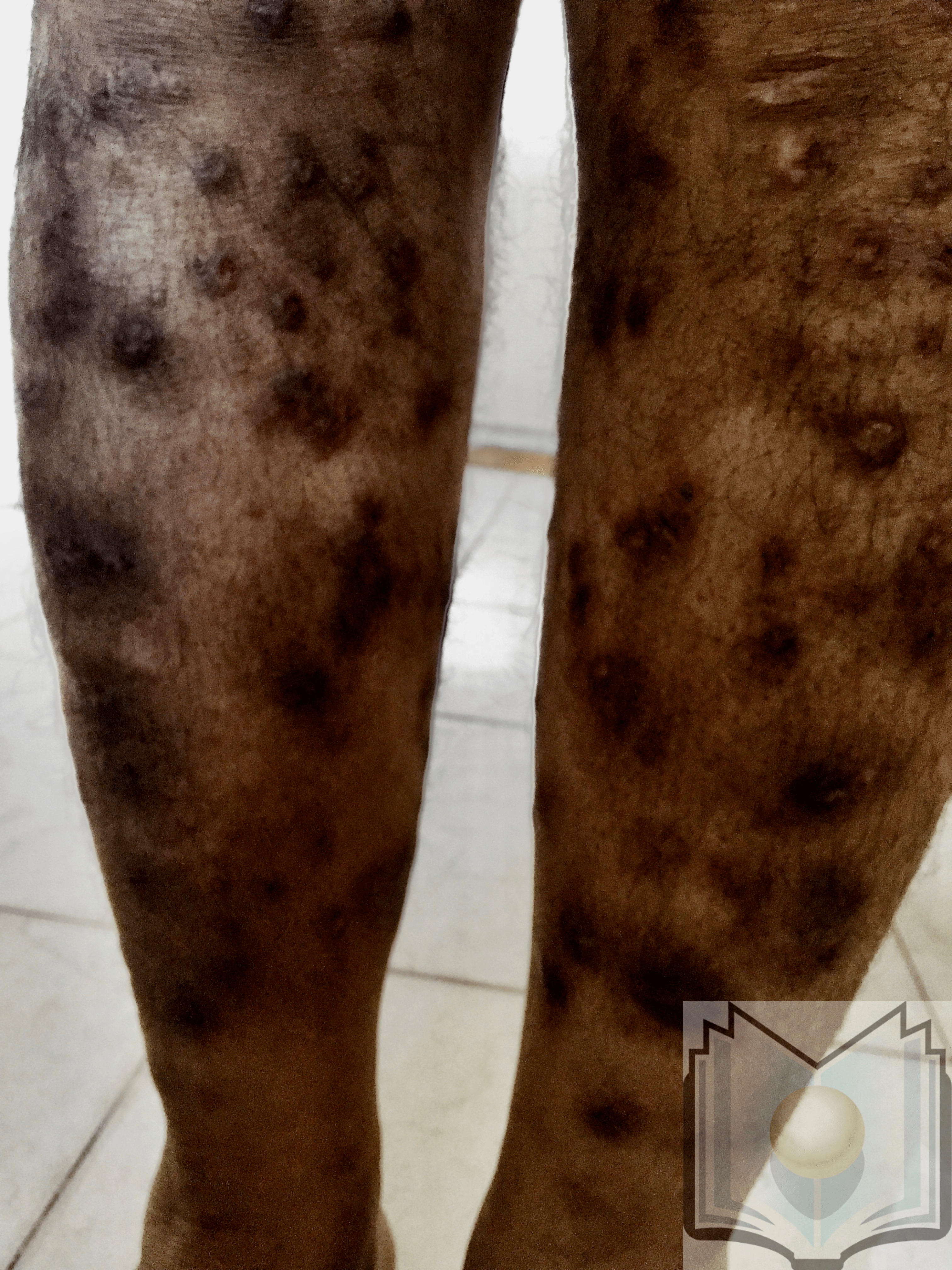[2]
Larson VA, Tang O, Stander S, Miller LS, Kang S, Kwatra SG. Association between prurigo nodularis and malignancy in middle-aged adults. Journal of the American Academy of Dermatology. 2019 Nov:81(5):1198-1201. doi: 10.1016/j.jaad.2019.03.083. Epub 2019 Apr 5
[PubMed PMID: 30954580]
[3]
Ständer S, Kwon P, Hirman J, Perlman AJ, Weisshaar E, Metz M, Luger TA, TCP-102 Study Group. Serlopitant reduced pruritus in patients with prurigo nodularis in a phase 2, randomized, placebo-controlled trial. Journal of the American Academy of Dermatology. 2019 May:80(5):1395-1402. doi: 10.1016/j.jaad.2019.01.052. Epub 2019 Mar 17
[PubMed PMID: 30894279]
Level 1 (high-level) evidence
[4]
Kowalski EH, Kneiber D, Valdebran M, Patel U, Amber KT. Treatment-resistant prurigo nodularis: challenges and solutions. Clinical, cosmetic and investigational dermatology. 2019:12():163-172. doi: 10.2147/CCID.S188070. Epub 2019 Feb 28
[PubMed PMID: 30881076]
[5]
Iking A, Grundmann S, Chatzigeorgakidis E, Phan NQ, Klein D, Ständer S. Prurigo as a symptom of atopic and non-atopic diseases: aetiological survey in a consecutive cohort of 108 patients. Journal of the European Academy of Dermatology and Venereology : JEADV. 2013 May:27(5):550-7. doi: 10.1111/j.1468-3083.2012.04481.x. Epub 2012 Feb 25
[PubMed PMID: 22364653]
Level 3 (low-level) evidence
[6]
Rowland Payne CM, Wilkinson JD, McKee PH, Jurecka W, Black MM. Nodular prurigo--a clinicopathological study of 46 patients. The British journal of dermatology. 1985 Oct:113(4):431-9
[PubMed PMID: 4063179]
[7]
Mattila JO, Vornanen M, Vaara J, Katila ML. Mycobacteria in prurigo nodularis: the cause or a consequence? Journal of the American Academy of Dermatology. 1996 Feb:34(2 Pt 1):224-8
[PubMed PMID: 8642086]
[8]
Jacob CI, Patten SF. Strongyloides stercoralis infection presenting as generalized prurigo nodularis and lichen simplex chronicus. Journal of the American Academy of Dermatology. 1999 Aug:41(2 Pt 2):357-61
[PubMed PMID: 10426933]
[9]
Nahass GT, Penneys NS. Merkel cells and prurigo nodularis. Journal of the American Academy of Dermatology. 1994 Jul:31(1):86-8
[PubMed PMID: 7517411]
[10]
Vaalasti A, Suomalainen H, Rechardt L. Calcitonin gene-related peptide immunoreactivity in prurigo nodularis: a comparative study with neurodermatitis circumscripta. The British journal of dermatology. 1989 May:120(5):619-23
[PubMed PMID: 2474315]
Level 2 (mid-level) evidence
[11]
Sonkoly E, Muller A, Lauerma AI, Pivarcsi A, Soto H, Kemeny L, Alenius H, Dieu-Nosjean MC, Meller S, Rieker J, Steinhoff M, Hoffmann TK, Ruzicka T, Zlotnik A, Homey B. IL-31: a new link between T cells and pruritus in atopic skin inflammation. The Journal of allergy and clinical immunology. 2006 Feb:117(2):411-7
[PubMed PMID: 16461142]
[12]
Boozalis E, Tang O, Patel S, Semenov YR, Pereira MP, Stander S, Kang S, Kwatra SG. Ethnic differences and comorbidities of 909 prurigo nodularis patients. Journal of the American Academy of Dermatology. 2018 Oct:79(4):714-719.e3. doi: 10.1016/j.jaad.2018.04.047. Epub 2018 May 4
[PubMed PMID: 29733939]
[13]
Fostini AC, Girolomoni G, Tessari G. Prurigo nodularis: an update on etiopathogenesis and therapy. The Journal of dermatological treatment. 2013 Dec:24(6):458-62. doi: 10.3109/09546634.2013.814759. Epub 2013 Jul 3
[PubMed PMID: 23767411]
[14]
Tanaka M, Aiba S, Matsumura N, Aoyama H, Tagami H. Prurigo nodularis consists of two distinct forms: early-onset atopic and late-onset non-atopic. Dermatology (Basel, Switzerland). 1995:190(4):269-76
[PubMed PMID: 7655104]
[15]
Tan WS, Tey HL. Extensive prurigo nodularis: characterization and etiology. Dermatology (Basel, Switzerland). 2014:228(3):276-80. doi: 10.1159/000358250. Epub 2014 Mar 22
[PubMed PMID: 24662043]
[16]
Magand F, Nacher M, Cazorla C, Cambazard F, Marie DS, Couppié P. Predictive values of prurigo nodularis and herpes zoster for HIV infection and immunosuppression requiring HAART in French Guiana. Transactions of the Royal Society of Tropical Medicine and Hygiene. 2011 Jul:105(7):401-4. doi: 10.1016/j.trstmh.2011.04.001. Epub 2011 May 28
[PubMed PMID: 21621233]
[17]
Lee MR, Shumack S. Prurigo nodularis: a review. The Australasian journal of dermatology. 2005 Nov:46(4):211-18; quiz 219-20
[PubMed PMID: 16197418]
[18]
Pereira MP, Mühl S, Pogatzki-Zahn EM, Agelopoulos K, Ständer S. Intraepidermal Nerve Fiber Density: Diagnostic and Therapeutic Relevance in the Management of Chronic Pruritus: a Review. Dermatology and therapy. 2016 Dec:6(4):509-517
[PubMed PMID: 27730494]
[19]
Fukushi S, Yamasaki K, Aiba S. Nuclear localization of activated STAT6 and STAT3 in epidermis of prurigo nodularis. The British journal of dermatology. 2011 Nov:165(5):990-6. doi: 10.1111/j.1365-2133.2011.10498.x. Epub 2011 Sep 29
[PubMed PMID: 21711341]
[20]
Weigelt N, Metze D, Ständer S. Prurigo nodularis: systematic analysis of 58 histological criteria in 136 patients. Journal of cutaneous pathology. 2010 May:37(5):578-86. doi: 10.1111/j.1600-0560.2009.01484.x. Epub 2009 Nov 30
[PubMed PMID: 20002240]
Level 1 (high-level) evidence
[21]
Ankad BS, Beergouder SL. Hypertrophic lichen planus versus prurigo nodularis: a dermoscopic perspective. Dermatology practical & conceptual. 2016 Apr:6(2):9-15. doi: 10.5826/dpc.0602a03. Epub 2016 Apr 30
[PubMed PMID: 27222766]
Level 3 (low-level) evidence
[22]
Vaidya DC, Schwartz RA. Prurigo nodularis: a benign dermatosis derived from a persistent pruritus. Acta dermatovenerologica Croatica : ADC. 2008:16(1):38-44
[PubMed PMID: 18358109]
[23]
Pereira MP, Lüling H, Dieckhöfer A, Steinke S, Zeidler C, Ständer S. Brachioradial Pruritus and Notalgia Paraesthetica: A Comparative Observational Study of Clinical Presentation and Morphological Pathologies. Acta dermato-venereologica. 2018 Jan 12:98(1):82-88. doi: 10.2340/00015555-2789. Epub
[PubMed PMID: 28902951]
Level 2 (mid-level) evidence
[24]
Nair PA, Patel T. Dermatoscopic Features of Prurigo Nodularis. Indian dermatology online journal. 2019 Mar-Apr:10(2):187-189. doi: 10.4103/idoj.IDOJ_224_18. Epub
[PubMed PMID: 30984602]
[25]
Nowak DA, Yeung J. Diagnosis and treatment of pruritus. Canadian family physician Medecin de famille canadien. 2017 Dec:63(12):918-924
[PubMed PMID: 29237630]
[26]
Przybilla B, Ring J, Völk M. [Total IgE levels in the serum in dermatologic diseases]. Der Hautarzt; Zeitschrift fur Dermatologie, Venerologie, und verwandte Gebiete. 1986 Feb:37(2):77-82
[PubMed PMID: 3957665]
[27]
Katayama C, Hayashida Y, Sugiyama S, Shiohara T, Aoyama Y. Corticosteroid-resistant prurigo nodularis: a rare syringotropic variant associated with hypohidrosis. European journal of dermatology : EJD. 2019 Apr 1:29(2):212-213. doi: 10.1684/ejd.2019.3498. Epub
[PubMed PMID: 30827950]
[28]
Legat FJ. The Antipruritic Effect of Phototherapy. Frontiers in medicine. 2018:5():333. doi: 10.3389/fmed.2018.00333. Epub 2018 Nov 30
[PubMed PMID: 30560129]
[29]
Gupta MA, Pur DR, Vujcic B, Gupta AK. Use of antiepileptic mood stabilizers in dermatology. Clinics in dermatology. 2018 Nov-Dec:36(6):756-764. doi: 10.1016/j.clindermatol.2018.08.005. Epub 2018 Aug 16
[PubMed PMID: 30446200]
[30]
Beck KM, Yang EJ, Sekhon S, Bhutani T, Liao W. Dupilumab Treatment for Generalized Prurigo Nodularis. JAMA dermatology. 2019 Jan 1:155(1):118-120. doi: 10.1001/jamadermatol.2018.3912. Epub
[PubMed PMID: 30427994]
[31]
Qureshi AA, Abate LE, Yosipovitch G, Friedman AJ. A systematic review of evidence-based treatments for prurigo nodularis. Journal of the American Academy of Dermatology. 2019 Mar:80(3):756-764. doi: 10.1016/j.jaad.2018.09.020. Epub 2018 Sep 25
[PubMed PMID: 30261199]
Level 1 (high-level) evidence
[32]
Siepmann D, Lotts T, Blome C, Braeutigam M, Phan NQ, Butterfass-Bahloul T, Augustin M, Luger TA, Ständer S. Evaluation of the antipruritic effects of topical pimecrolimus in non-atopic prurigo nodularis: results of a randomized, hydrocortisone-controlled, double-blind phase II trial. Dermatology (Basel, Switzerland). 2013:227(4):353-60. doi: 10.1159/000355671. Epub 2013 Nov 23
[PubMed PMID: 24281309]
Level 1 (high-level) evidence
[33]
Wong SS, Goh CL. Double-blind, right/left comparison of calcipotriol ointment and betamethasone ointment in the treatment of Prurigo nodularis. Archives of dermatology. 2000 Jun:136(6):807-8
[PubMed PMID: 10871962]
Level 1 (high-level) evidence
[34]
Patel T, Ishiuji Y, Yosipovitch G. Menthol: a refreshing look at this ancient compound. Journal of the American Academy of Dermatology. 2007 Nov:57(5):873-8
[PubMed PMID: 17498839]
[35]
Shintani T, Ohata C, Koga H, Ohyama B, Hamada T, Nakama T, Furumura M, Tsuruta D, Ishii N, Hashimoto T. Combination therapy of fexofenadine and montelukast is effective in prurigo nodularis and pemphigoid nodularis. Dermatologic therapy. 2014 May-Jun:27(3):135-9. doi: 10.1111/dth.12094. Epub 2013 Sep 17
[PubMed PMID: 24102897]
[36]
Hammes S, Hermann J, Roos S, Ockenfels HM. UVB 308-nm excimer light and bath PUVA: combination therapy is very effective in the treatment of prurigo nodularis. Journal of the European Academy of Dermatology and Venereology : JEADV. 2011 Jul:25(7):799-803. doi: 10.1111/j.1468-3083.2010.03865.x. Epub 2010 Oct 15
[PubMed PMID: 20946583]
[37]
Brenninkmeijer EE, Spuls PI, Lindeboom R, van der Wal AC, Bos JD, Wolkerstorfer A. Excimer laser vs. clobetasol propionate 0·05% ointment in prurigo form of atopic dermatitis: a randomized controlled trial, a pilot. The British journal of dermatology. 2010 Oct:163(4):823-31. doi: 10.1111/j.1365-2133.2010.09858.x. Epub
[PubMed PMID: 20491772]
Level 3 (low-level) evidence
[38]
Wiznia LE, Callahan SW, Cohen DE, Orlow SJ. Rapid improvement of prurigo nodularis with cyclosporine treatment. Journal of the American Academy of Dermatology. 2018 Jun:78(6):1209-1211. doi: 10.1016/j.jaad.2018.02.024. Epub 2018 Feb 10
[PubMed PMID: 29438756]
[39]
Klejtman T, Beylot-Barry M, Joly P, Richard MA, Debarbieux S, Misery L, Wolkenstein P, Chosidow O, Ingen-Housz-Oro S. Treatment of prurigo with methotrexate: a multicentre retrospective study of 39 cases. Journal of the European Academy of Dermatology and Venereology : JEADV. 2018 Mar:32(3):437-440. doi: 10.1111/jdv.14646. Epub 2017 Nov 7
[PubMed PMID: 29055135]
Level 2 (mid-level) evidence
[40]
Lear JT, English JS, Smith AG. Nodular prurigo responsive to azathioprine. The British journal of dermatology. 1996 Jun:134(6):1151
[PubMed PMID: 8763446]
[41]
Gupta R. Treatment of prurigo nodularis with dexamethasone-cyclophosphamide pulse therapy. Indian journal of dermatology, venereology and leprology. 2016 Mar-Apr:82(2):239. doi: 10.4103/0378-6323.174413. Epub
[PubMed PMID: 26924412]
[42]
Halvorsen JA, Aasebø W. Oral tacrolimus treatment of pruritus in prurigo nodularis. Acta dermato-venereologica. 2015 Sep:95(7):866-7. doi: 10.2340/00015555-2107. Epub
[PubMed PMID: 25804254]
[43]
Feldmeyer L, Werner S, Kamarashev J, French LE, Hofbauer GF. Atopic prurigo nodularis responds to intravenous immunoglobulins. The British journal of dermatology. 2012 Feb:166(2):461-2. doi: 10.1111/j.1365-2133.2011.10587.x. Epub 2011 Dec 5
[PubMed PMID: 21910702]
[44]
Chen M, Doherty SD, Hsu S. Innovative uses of thalidomide. Dermatologic clinics. 2010 Jul:28(3):577-86. doi: 10.1016/j.det.2010.03.003. Epub
[PubMed PMID: 20510766]
[45]
Kanavy H, Bahner J, Korman NJ. Treatment of refractory prurigo nodularis with lenalidomide. Archives of dermatology. 2012 Jul:148(7):794-6. doi: 10.1001/archdermatol.2011.2918. Epub
[PubMed PMID: 22801610]
[46]
Phan NQ, Lotts T, Antal A, Bernhard JD, Ständer S. Systemic kappa opioid receptor agonists in the treatment of chronic pruritus: a literature review. Acta dermato-venereologica. 2012 Sep:92(5):555-60. doi: 10.2340/00015555-1353. Epub
[PubMed PMID: 22504709]
[47]
Haas S, Capellino S, Phan NQ, Böhm M, Luger TA, Straub RH, Ständer S. Low density of sympathetic nerve fibers relative to substance P-positive nerve fibers in lesional skin of chronic pruritus and prurigo nodularis. Journal of dermatological science. 2010 Jun:58(3):193-7. doi: 10.1016/j.jdermsci.2010.03.020. Epub 2010 Apr 4
[PubMed PMID: 20417061]
[48]
Waldinger TP, Wong RC, Taylor WB, Voorhees JJ. Cryotherapy improves prurigo nodularis. Archives of dermatology. 1984 Dec:120(12):1598-600
[PubMed PMID: 6508332]
[49]
Stoll DM, Fields JP, King LE Jr. Treatment of prurigo nodularis: use of cryosurgery and intralesional steroids plus lidocaine. The Journal of dermatologic surgery and oncology. 1983 Nov:9(11):922-4
[PubMed PMID: 6630706]



